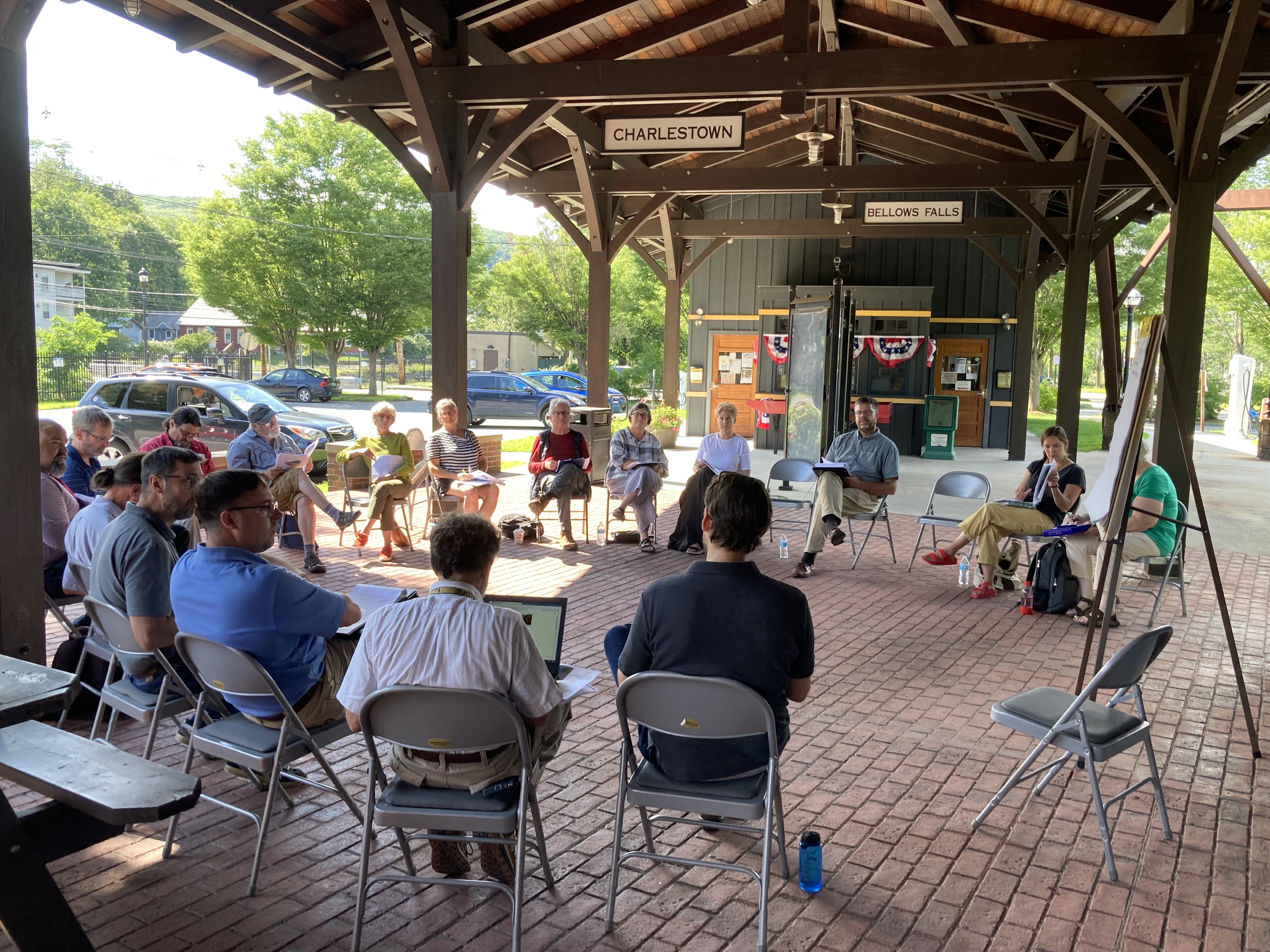
the Town of Rockingham/Bellows Falls

Incremental Development Alliance (IDA), a non-profit alliance of practitioners, helps identify where policies and practices are unnecessary barriers and partners with local organizations to improve the financial and regulatory ecosystem for small development projects. “Today, city-building is dominated by large developers with institutional investors who build in big chunks like subdivisions and shopping centers. However, the neighborhoods we love most tend to be ones that were built gradually over generations. That is what we mean by incremental development: small projects by local people over a long period of time. At IncDev, we call these small projects STEP Buildings. STEP Buildings are both a process and a product. They are the one-step-at-a-time approach to building cities that improve with age. They are also a suite of time-tested building types that we all know and love.”
IDA has been hired to provide direct technical assistance to the Town of Rockingham. This initiative is partially funded and staffed through Brattleboro Development Credit Corporation’s Southern Vermont Economy Project, made possible through USDA RCDI (Rural Community Development Initiative). These recorded sessions are part of the three-month direct technical assistance. The technical assistance is also funded by Vermont Council on Rural Development, Vermont Natural Resources Council, Preservation Trust of Vermont, Vermont Housing and Conservation Board, and Vermont Community Foundation.
Quick Links :
(for more info on each, please scroll down to appropriate sections)
FINAL TASK 1 SUMMARY:
Bellows Falls-VT_Task 1_ What We Heard Summary Memo
FINAL TASK 2 SUMMARY:
Summary PPT of Incremental Approaches
TARGET MARKET ANALYSES
Summary: Summary of Target Market Analyses for Bellows Falls
Residential: VT Bellows Falls Residential 05 01 21 Final
Commercial: VT Bellows Falls Commercial 04 12 21 Final
Appendix: VT Bellows Falls Appendix 04 12 21 Final
Introduction Target Market Analysis for Small Scale Projects presentation led by Sharon Woods to discuss how to understand how your market is segmented into socio-economic bands that have preferences towards the kinds of housing and commercial services they consume. Typical market studies overlook the diverse palette of housing form types between 1-20 units and under 5000 sf of commercial or industrial space. This presentation helps orient how this information can be harnessed to focus early development efforts into the best, most flexible product types for a community.
Presented by the Alliance Faculty, this lecture outlines typical barriers to small-scale development, examples of small projects in other locations, and general strategies community groups and governments can take to support redevelopment.
Presentation:
Presentation led by Alliance Faculty intended for an audience from the real estate development, city administration, and community partners. IDA will discuss administrative “contamination” that can create barriers and hurdles for small scale development and ways to improve those situations.
Presentation: The Dirty Dozen, Administrative Contamination – David Kim
Introduction to STEP Buildings presentation is intended for stakeholders who will be engaging in the technical steps of the Diagnostic and/or responding to the Diagnostic results for the Town of Rockingham OR anyone who is interested. This session gives the audience imagery to spark ideas for what they might want to see in their place by presenting both the philosophy behind and physical manifestation of Small-scale, Time-enhanced, Entrepreneurial, and Purposeful Buildings. There are over 50 STEP Buildings and a curated subset appropriate to your place will be used to examine the code and finance thresholds that affect them. This session gets down to brass-tacks: what it takes to finance, design, approve, construct, and rent out the buildings cities actually want to see.
Presentation:
Documents:
The Villiage of Bellows Falls, Vermont Residential Target Market Analysis: VT Bellows Falls Residential 05 01 21 Final
The Villiage of Bellows Falls, Vermont Commercial Target Market Analysis: VT Bellows Falls Commercial 04 12 21 Final
Appendix to Analysis: VT Bellows Falls Appendix 04 12 21 Final
A special meeting with the Incremental Development Alliance to hear more about the Target Market Analysis (TMA) that was conducted for the Town of Rockingham/Village of Bellows Falls. The first 45 minutes of the meeting focuses on market analytics, methodology and approach, study results, and next steps.
A Target Market Analysis is a unique approach to conducting housing and retail market studies. It focuses on studying the lifestyle preferences of households moving into and within local markets like ours. Household preferences range from inclination to be renters or owners; family composition and socio-economic diversity; income and price tolerance for new houses and for-lease units; and inclination to shop at new shops and businesses.
The study focused on measuring the magnitude of market gaps and potential for new housing units and retail space and identifying the optimal building formats for our city. The housing study will focus on missing formats like attached condos, townhouses, duplexes, triplexes, etc. The retail study will focus on small business opportunities ranging from merchants to services, and from entertainment venues to eateries.
Once completed, the market study will be used as a platform for additional work by the Incremental Development Alliance. The data will help inform a process of identifying optimal locations for reinvestment and identifying the highest and best use of site-specific development opportunities. The study results will also help guide and inform the city with future land use planning. Results can also help inform private developers and investors on the ideal retail and housing mix, scale, format, and locations for new mixed-use projects.
Led by Alliance Faculty, the Spot Test Report will review the constraints of existing regulatory and current financial conditions
on 3 development scenarios within the Village of Bellows Falls. The goal is to simulate the work of small developers looking at planning goals and regulations on given existing properties in order to identify development projects that make sense at a small scale.
In each Spot Test scenario, a STEP building is placed on a common lot size to show where the regulatory environment enables or prohibits desired buildings through typical parameters like setbacks, lot coverages, unit density, and parking requirements. Also included in each exercise is a “walking’ proforma that helps you understand the process of proforma development rather than tying to a specific outcome.
Presentation:
Bellows Falls Spot Tests Report Out-v2
Pro Formas:
ADU_Bellows-Falls_VT_Prototype_ROI_Model
Mansion-Flats-7_Bellows-Falls_VT_BuildingPrototyper_ROI_Model
ACU_Live-Work-addition_Bellows-Falls_VT_BuildingPrototyper_ROI_Model_v4.0.2
Presentation:
Summary PPT of Incremental Approaches
Join us in implementing these steps!:
Next Steps Meeting: June 30th, 5:30pm at the Waypoint Center in Bellows Falls
At the end of the IncDev technical assistance process, it is clear there are many small steps to take in order to improve Rockingham’s small scale developer ecosystem. In order to move forward and take those small steps, interested residents, landlords, business owners and local leaders will meet on a regular basis to review findings and create action items.
If you’d like to be a part of the Rockingham Incremental Development Working Group (RIDWG), please email development@rockbf.org to be added to the email list.

Investing in Bellows Falls Through Alternative Development Model Driven by Locals
When we mention “development,” many people tend to think of large new construction: the business park, the office complex, large clusters of homes or apartments. In this model, a few big players make the plans, provide the investment, and reap much of the benefits. What happens if we instead focus on a lot of individual “micro-developers,” each pursuing their own tiny development interests and goals. What is the effect on those individuals and their community? Are there advantages to this approach, and is it worth pursuing?
